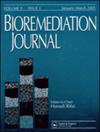Biological degradation of 2,4,6-trichlorophenol using anaerobic sequencing batch reactor equipped with a rotating biological bed
IF 1.4
4区 环境科学与生态学
Q3 ENVIRONMENTAL SCIENCES
引用次数: 0
Abstract
Abstract2, 4, 6-Triclorphenol is a halogenated aromatic compound with toxic, volatile, and odor properties. The anaerobic processes are superior to aerobic processes due to better dehalogenation of 2, 4, 6-Triclorphenol and easier control of releasing this toxic and odorous chemical compound into the air. However, anaerobic processes have lower reaction rates than aerobic processes. In this study, a rotating biological bed was used in an anaerobic sequencing batch reactor to increase the rate of anaerobic reactions. The anaerobic sequencing batch reactor equipped with a rotating biological bed removed more than 99% of the 2, 4, 6-Triclorphenol, 96% of total phenolic compounds, and more than 86% of its chemical oxidation demand in 2, 4, 6-Triclorphenol concentration of 430 mg/L and hydraulic retention time of 12 h. With the biological degradation of the 2, 4, 6-Triclorphenol by an anaerobic sequencing batch reactor Equipped with a rotating biological bed, more than 92% of the chlorine atoms in the structure of this compound were released into the effluent. Therefore, almost complete dehalogenation of 2, 4, 6-Triclorphenol is performed by this process. By removing the rotating biological bed from the anaerobic sequencing batch reactor equipped with a rotating biological bed, the bioreactor efficiency declined rapidly and progressed to failure. The role of rotating biological bed in dehalogenation (32%), biological degradation (10%), and mineralization (83%) of 2, 4, 6-Triclorphenol are very important. Therefore, a rotating biological bed has a significant role in promoting an anaerobic sequencing batch reactor. The anaerobic sequencing batch reactor equipped with a rotating biological bed can remove higher concentrations of 2, 4, 6-Triclorphenol at a lower hydraulic retention time than previously studied processes. Thus, the rotating biological bed can be an appropriate option for promoting anaerobic wastewater treatment plants that receive wastewater containing volatile, toxic, and complex organic compounds.Keywords: Anaerobic processbiological degradationrotating biological bed246-trichlorophenols Disclosure statementNo potential conflict of interest was reported by the authors.Additional informationFundingThe authors gratefully acknowledge the financial and technical support of the Urmia University of Medical Sciences, Iran.厌氧序批式反应器对2,4,6-三氯苯酚的生物降解研究
摘要2,4,6 -三氯酚是一种具有毒性、挥发性和气味的卤代芳香族化合物。厌氧工艺优于好氧工艺,因为它能更好地脱卤2,4,6 -三氯酚,并且更容易控制这种有毒和有气味的化合物释放到空气中。然而,厌氧过程的反应速率比好氧过程低。在厌氧序批式反应器中采用旋转生物床来提高厌氧反应速率。在2,4,6 -三氯酚浓度为430 mg/L、水力停留时间为12 h的条件下,厌氧间歇式厌氧顺序反应器对2,4,6 -三氯酚的生物降解率达到了99%以上,对总酚类化合物的去除率达到了96%以上,对化学氧化需氧量达到了86%以上。该化合物结构中超过92%的氯原子被释放到污水中。因此,2,4,6 -三氯酚的脱卤几乎完全通过该工艺进行。在厌氧序批式反应器中去除旋转生物床后,生物反应器效率迅速下降,并逐渐走向失效。旋转生物床对2,4,6 -三氯酚的脱卤(32%)、生物降解(10%)和矿化(83%)具有重要作用。因此,旋转生物床对厌氧序批式反应器具有重要的促进作用。与之前研究的工艺相比,配备旋转生物床的厌氧序批式反应器可以在更短的水力停留时间内去除更高浓度的2,4,6 -三氯酚。因此,旋转生物床可以是促进厌氧废水处理厂的适当选择,该厌氧废水处理厂接收含有挥发性,有毒和复杂有机化合物的废水。关键词:厌氧工艺生物降解旋转生物床246-三氯酚披露声明作者未报告潜在利益冲突作者感谢伊朗乌尔米娅医学科学大学的财政和技术支持。
本文章由计算机程序翻译,如有差异,请以英文原文为准。
求助全文
约1分钟内获得全文
求助全文
来源期刊

Bioremediation Journal
ENVIRONMENTAL SCIENCES-
CiteScore
5.30
自引率
0.00%
发文量
36
审稿时长
9 months
期刊介绍:
Bioremediation Journal is a peer-reviewed quarterly that publishes current, original laboratory and field research in bioremediation, the use of biological and supporting physical treatments to treat contaminated soil and groundwater. The journal rapidly disseminates new information on emerging and maturing bioremediation technologies and integrates scientific research and engineering practices. The authors, editors, and readers are scientists, field engineers, site remediation managers, and regulatory experts from the academic, industrial, and government sectors worldwide.
High-quality, original articles make up the primary content. Other contributions are technical notes, short communications, and occasional invited review articles.
 求助内容:
求助内容: 应助结果提醒方式:
应助结果提醒方式:


